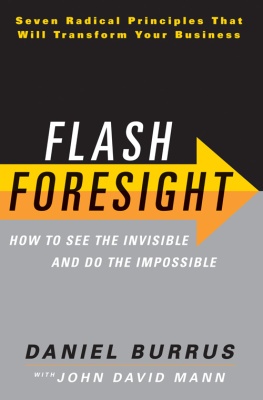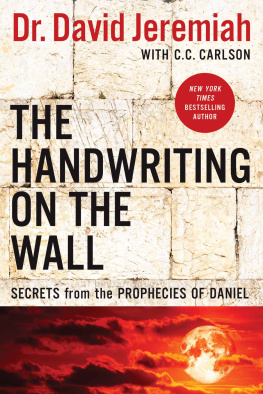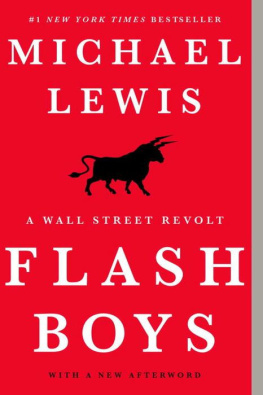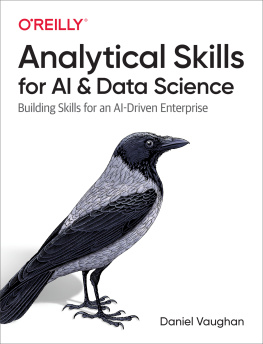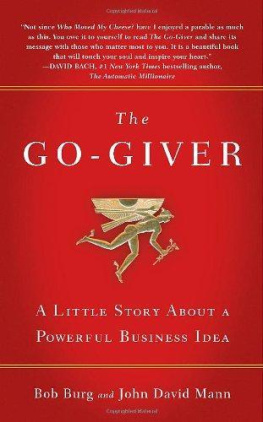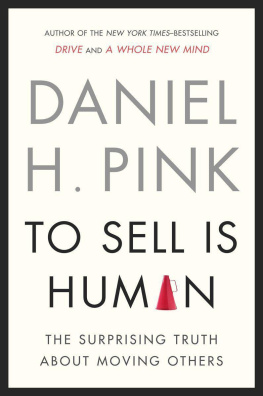Seven RadicalPrinciples That will Transform Your Business
FlashForesight
How to See theInvisible and Do the Impossible
Daniel Burrus
with John DavidMann

D EDICATION
To my wife, my soul mate, my best friend, and biggest fan, Sharon: you are a constant source of love and inspiration.
And to the millions of people around the world who have been in my audiences, read my books, and taken action on the ideas I sparked in their minds. It is your positive actions that fuel my passion for continuing to inspire you to shape a better tomorrow.
E PIGRAPH
Flash
n. 1. a sudden burst of light or glint from a reflective surface. 2. an insight that occurs suddenly and unexpectedly: a flash of inspiration .
Foresight
n. 1. knowledge or insight gained by looking into the future. 2. perception of the nature of events before they occur.
Flash Foresight
n. a sudden burst of insight about the future that produces a new and radically different way of doing something that will open up invisible opportunities and solve seemingly impossible problems before they happen.
C ONTENTS
S omethinggave Dale Morgen a big idea.
Like most of us, Dale was concerned about therising cost of energy, the problems of environmental pollution and climatechange, and the politics of petroleum. Like most of us, he also knew that thenuclear-power alternative creates its own problems, including radioactive wasteand the nagging threat of a catastrophic accident, not to mention thepossibility of theft and nuclear terrorism.
However, unlike most of us, Dale is an accomplishedinventor with more than thirty wildly successful patents under his belt. In the course of his work he has honed acertain skill, and that skill is the something thatgave him his big idea. I call it flash foresight ,and the purpose of this book is to show you how it works so you can use it, too,in your career and in your life.
Flash foresight uses the data of your five senses,as well as that intuitive sixth sense we all have that some call a gut feeling or hunch . Butflash foresight goes further, because in using it you synthesize those sensoryand intuitive faculties and project them forward through the dimension of time . A flash foresight isa blinding flash of the future obvious. It is an intuitive grasp of theforeseeable future that, once you see it, reveals hidden opportunities andallows you to solve your biggest problems before they happen. Flash foresight will allow anyone to both see and shape his or her future.
Im not telling you anything you dont already knowinstinctively. Youve had flash foresights; we all have. They are those fleetingglimpses we sometimes have of where things might be heading. Have you ever said,I knew I should have done that, or I knew that would happen? Thats hindsight, and ithappens because you dont typically know ahead of time when your hunch isaccurate and when its not. Learning how to make that distinctionbetweenglimpses of the future that are reliable foresight, and those that are simplyhunchesis what this book is about. Flash foresight is a sensibility, a skillyou can develop, refine, and strengthen. Ill show you how it works and how youcan make it work for you on a regular basis.
Through the pages of FlashForesight , well look at real people with real problems who havediscovered how to find real solutions. Well see how hundreds of overworkedcritical care nurses were able to add more than three hours of free time intotheir impossibly busy days; how a struggling urban school district found a wayto generate the income to pay for its own endangered programswithout having tospend a dime; and how a phone company is transforming the social and economiclandscape of Africa by doing something its American competitors never thoughtof. Well look at dozens of examples of how people just like you have used flashforesight to see the invisible and do the impossible.
Lets start with our inventor Dale and see how heused this powerful principle to arrive at his great idea.
Dale knew that there is another approach to ourworsening energy crisis that does not use fossilfuels, does not produce greenhouse gases or anyother pollution, does not create radioactive wasteor pose any other environmental dangers. Its called nuclear fusion , and many scientists believe it could become theenergy source of the twenty-first century and beyond.
Lets say you burn a certain amount of hydrogenand oxygen in todays most efficient fuel cell, explains Morgen, and you getten electron volts. Take two hydrogen isotopes and fuse them, now you get 16.7 million electronvolts. Fusing the hydrogen from a bathtubs worth of water would produce thesame amount of energy youd get from burning forty trainloads of coal. Arelatively tiny amount of ocean water would provide everyone on the planet withall the energy we could ever use for the next 50,000 years. And the onlyby-product is harmless, nonradioactive helium.
Understandably, this prospect has a lot of majorinternational players hot on the fusion trail. For example, a consortium oftwenty countries, including the United States, China, Japan, Korea, Russia, anda half-dozen European countries, is building a massive, multibillion-dollarfacility in southern France. The International Thermonuclear ExperimentalReactor (ITER) is the most expensive project ever mounted in pursuit of thisholy grail. At Californias famous Lawrence Livermore lab, another fusionfacility is under construction that will span three football fields to blast itsmillimeter-sized hydrogen-fuel pellets with massive lasers.
However, theres a problem. So far, even with thesemassive and astronomically costly facilities, the fusion reaction requires moreenergy going in than it yields in output. Like an investment that keeps losingmoney, todays fusion reactors produce a net energy loss . The largest functioning fusion reactor in the world is theU.K.s Joint European Torus (JET), yet even that facility has been able to reacha maximum output of barely two-thirds the input requiredlike investing $100 toget back a total return of less than $65.
And thats where Dales idea comes into thepicture. His flash foresight was this: Instead of makingthese facilities bigger and bigger, why not make them radically smaller? In fact, why not make a fusion reactor so small you cant even see itsosmall it would be built out of single molecules? In a word: nanofusion .
Dale is not alone in this idea; he is one of ahandful of early innovators who are exploring the emerging field of nanofusion.Dales model is similar to the Lawrence Livermore reactor in concept, onlyinstead of firing mile-long lasers at small glass pellets, his reactor wouldfire a nanolaser made from a single carbon moleculecalled a nanotube at hydrogen isotopes wrapped inside anothertype of carbon molecule called a buckyball . Thismaterial has a much higher purity and densityand lo and behold, it produces a net positive yield : more energy coming out thanit takes to make the reaction. Potentially, says Dale, vastly more.
Imagine the impact such a technology would have onthe world. For all practical purposes, there would be no more energy crisis.Oil-producing nations would become just nations like any otherstill producingoil, but no longer supplying the bulk of our energy needs. We would have enoughenergy to fuel our global economy for centuriesconceivably, foreverand withoutproducing any greenhouse gases or radioactive waste.
A lot of the other guys in fusion didnt even wantto hear about this idea, at first, says Dale. They thought we were crazybutthey said that about my other inventions, too. The long list of crazyinventions in whose development Dales keen sense of flash foresight has playeda key role includes the personal digital assistant (PDA) and matrix control forLCD and plasma TVs.
Next page
